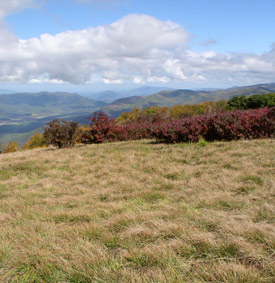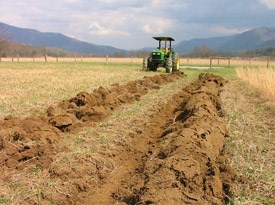Exotic Invasive Plant Species Control
Exotic Invasive species’ management is important to protect the Park’s landscape and to comply with the Executive Order on Invasive Species.
What are exotic invasive plant species? An exotic, invasive species is not native to an area and displaces native species. Take kudzu as an example: a highly vigorous and adaptive species from Japan, kudzu brought to stabilize slopes now pours down hillsides, choking out native plants by blocking light and using up soil nutrients and water. Over time, exotic invasive species such as kudzu change plant communities and sometimes entire ecosystems.
How big is the problem? Where do exotic plants come from? In the Great Smoky Mountains, scientists have counted 350 exotic plant species. They come from a few sources:
- Pre-Park home-site landscaping
- Gravel and topsoil brought into the park
- Visitors’ shoes, tires, and floormats
- Animal and wind deposition, especially following fires in the park
Of the 350 species, the park actively controls 50—the ones that are exotic AND invasive. These include kudzu, multiflora rose, coltsfoot, and garlic mustard, plants that will take over native species’ habitat and thereby alter the food chain, fire regimes, and biodiversity.
How are they controlled? The park’s exotic plant treatment program has deep roots. Beginning in the 1940s and 1950s, the park was already treating kudzu and multiflora rose. In the 1980s vegetation managers mapped and documented several exotic, invasive species, and since the 1990s the park has had a successful program combining chemical and manual control, as well as prevention of new plant introductions. When possible, vegetation managers pull or cut invasive exotic plants. When this isn’t practical, they spray selective herbicides or cut trees and paint the stumps with herbicide.
Does management work? With persistence, yes. Because Great Smoky Mountains National Park began its invasive species control program early, it has fewer rampant exotic populations than do other parks of the same size. The program involves systemic treatment, beginning with thorough surveys, accurate documentation and mapping, best management practices for control, and consistent monitoring and re-treatment. Volunteers often work in conjunction with managers so efforts can continue all over the park.
Pest & Disease Monitoring and Management
Biologists and foresters at the Park use Integrated Pest Management (IPM) to control exotic and invasive pests. There are three types of IPM: mechanical (such as hand-pulling weeds), cultural (such as changing behavior to prevent or reduce pests), and chemical (using approved pesticides or herbicides). Managers deal with pests in forests, fields, and even park buildings, trying to protect native species and people.
Here are examples of five forest insect pests and diseases in the Great Smoky Mountains that managers actively monitor:
Balsam Woolly Adelgid (BWA) - An aphid-like insect, BWA killed 90 percent of mature fir trees in the park since 1962 when it was first found in the park. The Fraser fir, a federally listed species of concern and a southern Appalachian endemic (meaning it’s found only in these mountains, and most of them are found within the boundaries of the Park), has been hit hard. Managers spray fir trunks with insecticidal soap, although there is no completely effective treatment. Fir stands that survived have begun to reproduce in many areas.
Beech Disease - Beech stands have been devastated in many areas of the Park by a combination of non-native beech scale and a species of Nectria fungus first identified in the late 1980s. Look for loss in high elevation beech gaps along the Appalachian Trail.
Butternut Canker - The butternut canker causes lens shaped bark wounds and lesions on butternut tree nuts and branches. The disease first appeared in Wisconsin in 1967, although no one knows where it originated. Scientists began monitoring 75 butternut trees in 1987.
Dogwood Anthracnose - Many flowering dogwoods in the Park—and in the United States—are afflicted with this fungus. Its origins are unknown, and there are no effective treatments. Vegetation managers monitor surviving dogwood.
Hemlock Woolly Adelgid (HWA)—Since 1992, hemlock woolly adelgid or HWA, has infested eastern hemlocks throughout the Park. HWA is an aphid-like insect that feeds at the base of hemlock needles, killing trees directly or weakening them so secondary pests such as hemlock borer eventually kill the trees. Foresters treat the trees with systemic chemical control (pouring insecticide around the tree base), foliar spray of insecticidal soap or oil, and/or biological control (using predatory beetles). Most untreated hemlocks are dying.
Pests and disease come to the park in many different ways. Once in the United States, the Hemlock Woolly Adelgid spread by itself from forest to forest over many years, while the Emerald Ash Borer, another insect pest, arrives on firewood that campers bring into the park from infested areas. Read more about the Firewood Quarantine to see how you can help stop the spread of this invasive and destructive insect.
Restoration of Native Vegetation & Landscapes

NPS-maintained habitat on Gregory Bald.
NPS photo.
All over the park, we see landscapes in flux: once-logged forests are maturing, streams that were straightened are meandering, and homesites once cleared for gardens and yards are growing over with brambles and flowers. The story of the Great Smoky Mountains’ forests and fields intertwines with the story of human settlement here. Once the human disturbance is gone, native vegetation often returns unaided. Sometimes, though, park employees need to actively manage landscapes that have been altered by past (and current) human activity, in order to restore native species and the habitat they provide.
To restore landscapes, vegetation managers look to the human story of disturbance, and to similar landscapes that can tell them which native species existed before logging, farming, clearing, or draining. Then they collect seeds from native plants—often a tricky, time consuming business—from nearby places in the park, and mix them so plants are represented in the right proportions.
Restoring native species is important for several reasons:
- To preserve native wildlife—All of the animals you come to see in the park evolved to fit in certain ecological “niches,” which includes eating specific species of plants (or the animals that ate those plants), and using those plants for shelter
- To restore plants into native nutrient cycling, often re-instituting links in a chain connecting soil, fungus, microbes, and other plants in ways we don’t yet fully understand
- To provide visitors with a view of undeveloped Appalachian landscapes
Some landscapes currently being restored or re-vegetated:
- Cades Cove—meadows and wetlands
- Foothills Parkway
- Gregory and Andrews Balds
- Areas in the Park disturbed for utility, bridge, or road construction
|


